Changes in Land Use Due to the Development of Photovoltaic Solar Energy in the Region of Murcia (Spain)
Abstract
1. Introduction
Framework Governing Photovoltaic Solar Energy in Spain
2. Methods
3. Results
4. Discussion
5. Conclusions
Author Contributions
Funding
Data Availability Statement
Conflicts of Interest
References
- European Commission. Energy Dependence in the EU. 2023. Available online: https://ec.europa.eu/energy (accessed on 14 July 2024).
- Molina Ibáñez, M.; Chicharro Fernández, E. Fuentes de Energía y Materias Primas; Editorial Síntesis. Colección Geografía de España: Madrid, Spain, 1988; 136p. [Google Scholar]
- Barral, M.Á.; Díez, A.R.; Prados, M.-J.; García-Marín, R.; Delicado, A. Energías renovables y cambios de usos del suelo en el sur de la Península Ibérica: Una lectura territorial de la política energética. Boletín Asoc. Geógrafos Españoles 2023, 97, 3356. [Google Scholar] [CrossRef]
- Eurostat. Energy Statistics. 2023. Available online: https://ec.europa.eu/eurostat (accessed on 14 July 2024).
- European Commission. The European Green Deal. 2019. Available online: https://ec.europa.eu/green-deal (accessed on 8 September 2024).
- IEA. World Energy Outlook 2023; International Energy Agency: Paris, France, 2023. [Google Scholar]
- Red Eléctrica de España. Spanish Electricity System Report 2022. 2023. Available online: https://www.sistemaelectrico-ree.es/2022/informe-del-sistema-electrico/generacion/generacion-de-energia-electrica/generacion-renovable-de-energia-electrica (accessed on 10 September 2024).
- Torrente, C.J.; Reca, J.; López-Luque, R.; Martínez, J.; Casares, F.J. Simulation Model to Analyze the Spatial Distribution of Solar Radiation in Agrivoltaic Mediterranean Greenhouses and Its Effect on Crop Water Needs. Appl. Energy 2024, 353, 122050. [Google Scholar] [CrossRef]
- Gorjian, S.; Bousi, E.; Özdemir, Ö.E.; Trommsdorff, M.; Kumar, N.M.; Anand, A.; Kant, K.; Chopra, S.S. Progress and Challenges of Crop Production and Electricity Generation in Agrivoltaic Systems Using Semi-Transparent Photovoltaic Technology. Renew. Sustain. Energy Rev. 2022, 158, 112126. [Google Scholar] [CrossRef]
- Feuerbacher, A.; Herrmann, T.; Neuenfeldt, S.; Laub, M.; Gocht, A. Estimating the Economics and Adoption Potential of Agrivoltaics in Germany Using a Farm-Level Bottom-up Approach. Renew. Sustain. Energy Rev. 2022, 168, 112784. [Google Scholar] [CrossRef]
- Roddis, P.; Roelich, K.; Tran, K.; Carver, S.; Dallimer, M.; Ziv, G. What Shapes Community Acceptance of Large-Scale Solar Farms? A Case Study of the UK’s First ‘Nationally Significant’ Solar Farm. Sol. Energy 2020, 209, 235–244. [Google Scholar] [CrossRef]
- Hermoso, V.; Bota, G.; Brotons, L.; Morán-Ordóñez, A. Addressing the Challenge of Photovoltaic Growth: Integrating Multiple Objectives towards Sustainable Green Energy Development. Land Use Policy 2023, 128, 106592. [Google Scholar] [CrossRef]
- van de Ven, D.J.; Capellán-Pérez, I.; Arto, I.; Cazcarro, I.; de Castro, C.; González-Eguino, M. The Potential Land Requirements and Related Land Use Change Emissions of Solar Energy. Sci. Rep. 2021, 11, 2907. [Google Scholar] [CrossRef]
- Pascaris, A.S.; Schelly, C.; Rouleau, M.; Pearce, J.M. Do Agrivoltaics Improve Public Support for Solar? A Survey on Perceptions, Preferences, and Priorities. Green Technol. Resilient Sustain. 2022, 2, 8. [Google Scholar] [CrossRef]
- Torma, G.; Aschemann-Witzel, J. Social Acceptance of Dual Land Use Approaches: Stakeholders’ Perceptions of the Drivers and Barriers Confronting Agrivoltaics Diffusion. J. Rural Stud. 2023, 97, 610–625. [Google Scholar] [CrossRef]
- Soto-Gómez, D. Integration of Crops, Livestock, and Solar Panels: A Review of Agrivoltaic Systems. Agronomy 2024, 14, 1824. [Google Scholar] [CrossRef]
- Widmer, J.; Christ, B.; Grenz, J.; Norgrove, L. Agrivoltaics, a Promising New Tool for Electricity and Food Production: A Systematic Review. Renew. Sustain. Energy Rev. 2024, 192, 114277. [Google Scholar] [CrossRef]
- CREM Statistical Portal of the Region of Murcia. 2024. Available online: https://econet.carm.es/ (accessed on 10 September 2024).
- Gazheli, A.; Di Corato, L. Land-use change and solar energy production: A real option approach. Agric. Financ. Rev. 2013, 73, 507–525. [Google Scholar] [CrossRef]
- Prados Velasco, M.J.; Pallarès-Blanch, M.; García Marín, R.; Del Valle Ramos, C. Renewable Energy Plants and Business Models: A New Rural Development Perspective. Energies 2023, 14, 4512. [Google Scholar]
- Boczar, A.C.A.; Gabrich, F.A. Contratos utilizados na exploração de terras rurais para a geração de energia fotovoltaica. Rev. Bras. Direito Empres. 2023, 7, 20–40. [Google Scholar] [CrossRef]
- Pastor, F. La Fotovoltaica ‘Recalienta’ el Campo y Multiplica por Cuatro las Rentas Agrarias. Diario la Información. 2023. Available online: https://www.juntacentral.es/sites/default/files/prensa/2021-03/18-03-21_lainformacion.pdf (accessed on 20 September 2024).
- Segura, E.; Belmonte, L.M.; Morales, R.; Somolinos, J.A. A strategic analysis of photovoltaic energy projects: The case study of Spain. Sustainability 2023, 15, 12316. [Google Scholar] [CrossRef]
- Reinert, M. How science is helping farmers to find a balance between agriculture and solar farms. Nature 2024. Available online: https://www.nature.com/articles/d41586-024-00518-6 (accessed on 10 October 2024).
- Toledo, C.; Scognamiglio, A. Agrivoltaic Systems Design and Assessment: A Critical Review, and a Descriptive Model towards a Sustainable Landscape Vision (Three-Dimensional Agrivoltaic Patterns). Sustainability 2021, 13, 6871. [Google Scholar] [CrossRef]
- Agostini, A.; Colauzzi, M.; Amaducci, S. Innovative agrivoltaic systems to produce sustainable energy: An economic and environmental assessment. Appl. Energy 2020, 281, 116102. [Google Scholar] [CrossRef]
- Guaita-Pradas, I.; Marques-Pérez, I.; Gallego, Á.; Segura García del Río, B. Analyzing territory for the sustainable development of solar photovoltaic power using GIS databases. Environ. Monit. Assess. 2019, 191, 764. [Google Scholar] [CrossRef]
- Pérez Díaz, A.; Leco Berrocal, F. Energías renovables y desarrollo local en Extremadura. Estud. Geográficos 2022, 83, e102. [Google Scholar] [CrossRef]
- Gómez Espín, J.M.; Gil Meseguer, E. Estrategias de desarrollo rural frente a grandes parques de energía solar foto-voltaica. La Comunidad de Regantes de Puerto Lumbreras modelo de gobernanza local. In Proceedings of the XXVII Congreso de la Asociación de Geógrafos Españoles/AGE), Tenerife, Spain, 14–17 December 2021. [Google Scholar]
- Díaz-Cuevas, P.; Orozco Frutos, G.; Prieto Campos, A.; Pérez Pérez, B. Geografía de la energía solar en Andalucía (Sur de España): Nuevos datos y posibilidades de análisis. Cuad. Geográficos 2023, 62, 160–180. [Google Scholar] [CrossRef]
- Mata Olmo, R.; Requejo Liberal, J. El suelo fértil, tercer pilar del patrimonio territorial. In Agricultura y Ganadería Familiar en España. Anuario 2022; Fundación de Estudios Rurales and MAPA: Madrid, Spain, 2022; pp. 169–176. [Google Scholar]
- Ministerio de Transición Ecológica y Reto Demográfico (MITECO). Memoria Sobre Zonificación Ambiental para la Implantación de Energías Renovables: Eólica y Fotovoltaica. Sensibilidad Ambiental y Clasificación del Territorio; Ministerio de Transición Ecológica y Reto Demográfico: Madrid, Spain, 2020. [Google Scholar]
- Espejo Marín, C.; Aparicio Guerrero, A.E.; García-Marín, R. Los inicios de la producción de energía solar fotovoltaica flotante sobre superficies de agua en España. An. Geogr. Univ. Complut. 2023, 43, 327–358. [Google Scholar] [CrossRef]
- Buitrago, M. El Ministerio Regula el Montaje de Fotovoltaicas en los Embalses ante el Recelo de los Regantes. Diario La Verdad. 10 July 2024. Available online: https://www.laverdad.es/murcia/ministerio-regula-montaje-fotovoltaicas-embalses-ante-recelo-20240710011028-nt.html (accessed on 10 September 2024).
- Frolova Ignatieva, M.; Espejo Marín, C.; Baraja Rodríguez, E.; Prados Velasco, M.J. Paisajes emergentes de las energías re-novables en España. Boletín De La Asoc. De Geógrafos Españoles (BAGE) 2014, 66, 223–252. [Google Scholar]
- Buitrago, M. El ‘Boom’ de los Megaparques Multiplicará por Cuatro la Energía solar Fotovoltaica de la Región de Murcia. Diario La Verdad. 12 February 2023. Available online: https://www.laverdad.es/economia-region-murcia/boom-megaparques-multiplicara-20230212211056-nt.html (accessed on 12 September 2024).
- EFQ Región de Murcia, Territorio de la Energía Fotovoltaica. Diario La Verdad. 27 November 2024. Available online: https://www.laverdad.es/economia-region-murcia/region-murcia-territorio-energia-fotovoltaica-20241127005015-nt.html (accessed on 28 November 2024).
- Martínez Medina, R.; Gil Meseguer, E.; Gómez-Gil, J.M.; Gómez Espín, J.M. Políticas públicas de ayudas para la mejora, modernización e innovación en el regadío de la Región de Murcia. Seguridad Hídrica. In Proceedings of the V Congreso nacional de Agua, Cox, Spain, 14–15 September 2023. [Google Scholar]
- Navarro, D. La Polémica por la Planta Solar de Puerto Lumbreras Alcanza Lorca. Diario La Opinión de Murcia. 6 May 2024. Available online: https://www.laopiniondemurcia.es/municipios/2024/05/06/planta-solar-puerto-lumbreras-lorca-101929274.html (accessed on 20 September 2024).
- Nicolas, J. Los Vecinos se Rebelan Contra la Planta Solar de la Desaladora de Torrevieja. Diario La Verdad. 5 May 2024. Available online: https://www.laverdad.es/orihuela-torrevieja/vecinos-rebelan-planta-solar-desaladora-torrevieja-20240505092551-nt.html (accessed on 20 September 2024).
- López, A. Ultiman el Montaje de Cinco Huertos Solares y 17 Proyectos de Cartagena Avanzan en Medio Ambiente, Diario La Verdad. 26 May 2024. Available online: https://www.laverdad.es/murcia/cartagena/ultiman-montaje-cinco-huertos-solares-proyectos-cartagena-20240526082054-nt.html (accessed on 20 September 2024).
- ICAL Asaja Denuncia que Continúa la Expropiación de Tierras para Macroparques Fotovoltaicos. La Nueva Crónica, Diario Leonés de Información General. 10 April 2024. Available online: https://www.lanuevacronica.com/actualidad/asaja-denuncia-continua-expropiacion-tierras-macroparques-fotovoltaicos_154785_102.html (accessed on 20 September 2024).
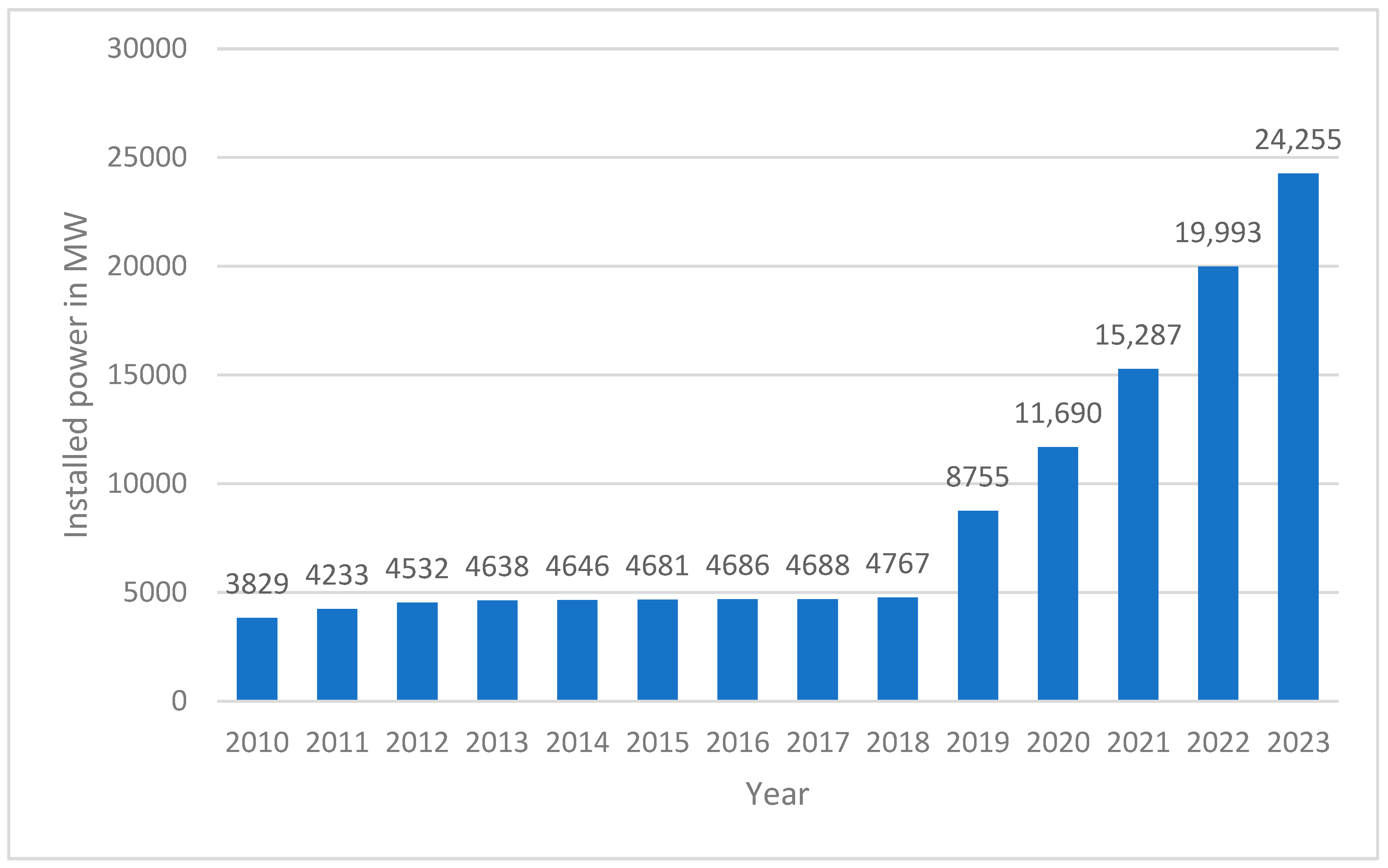
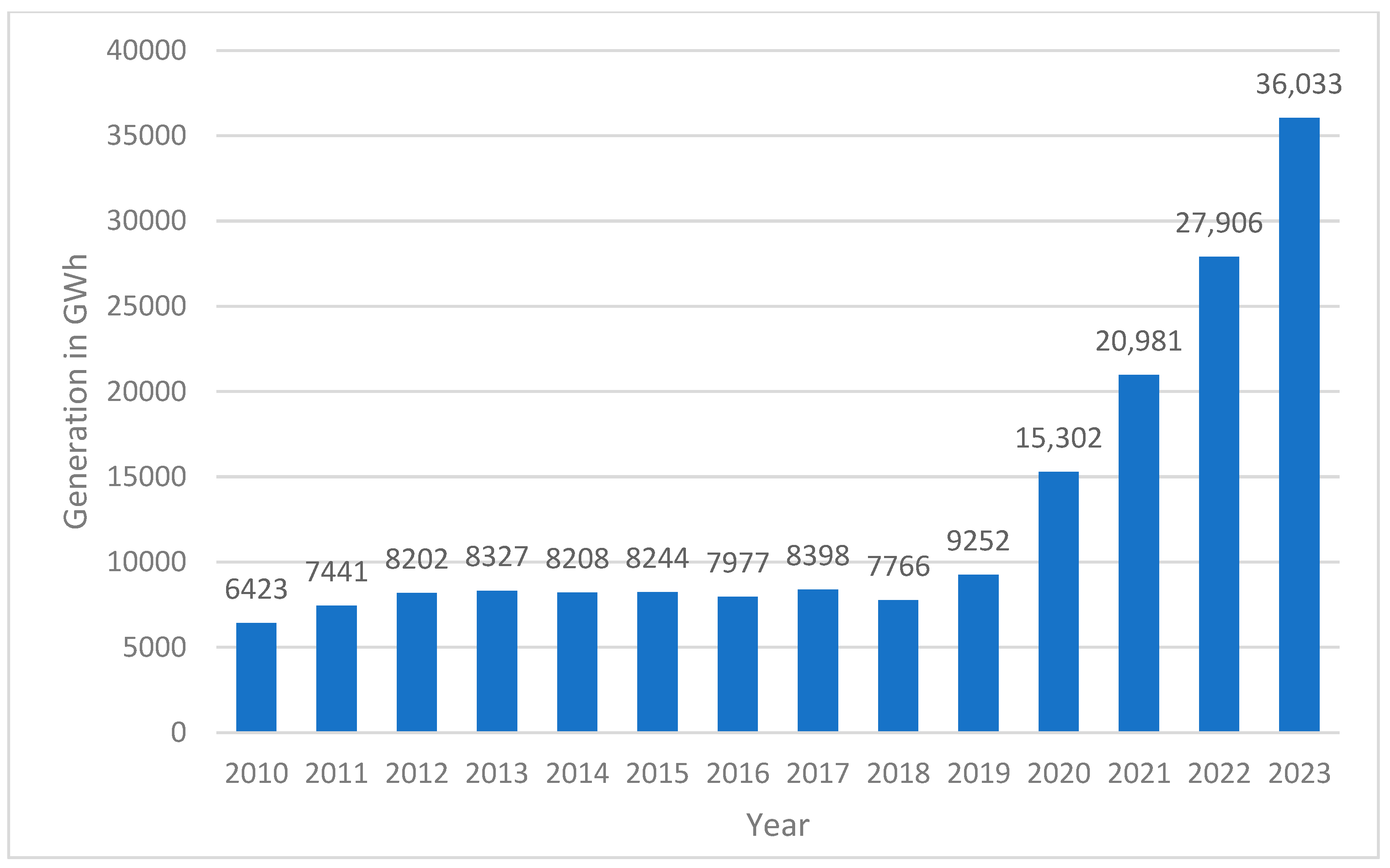
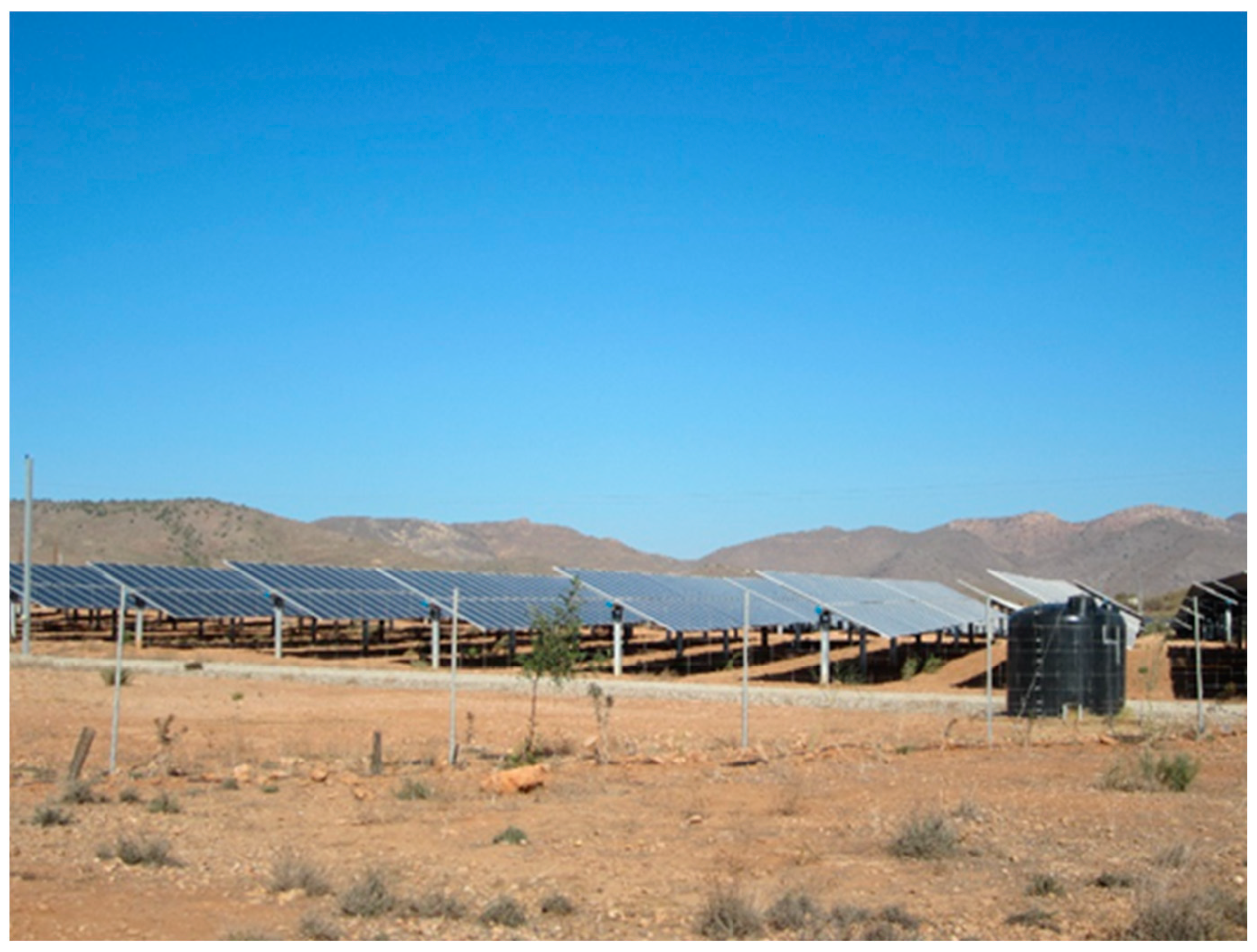
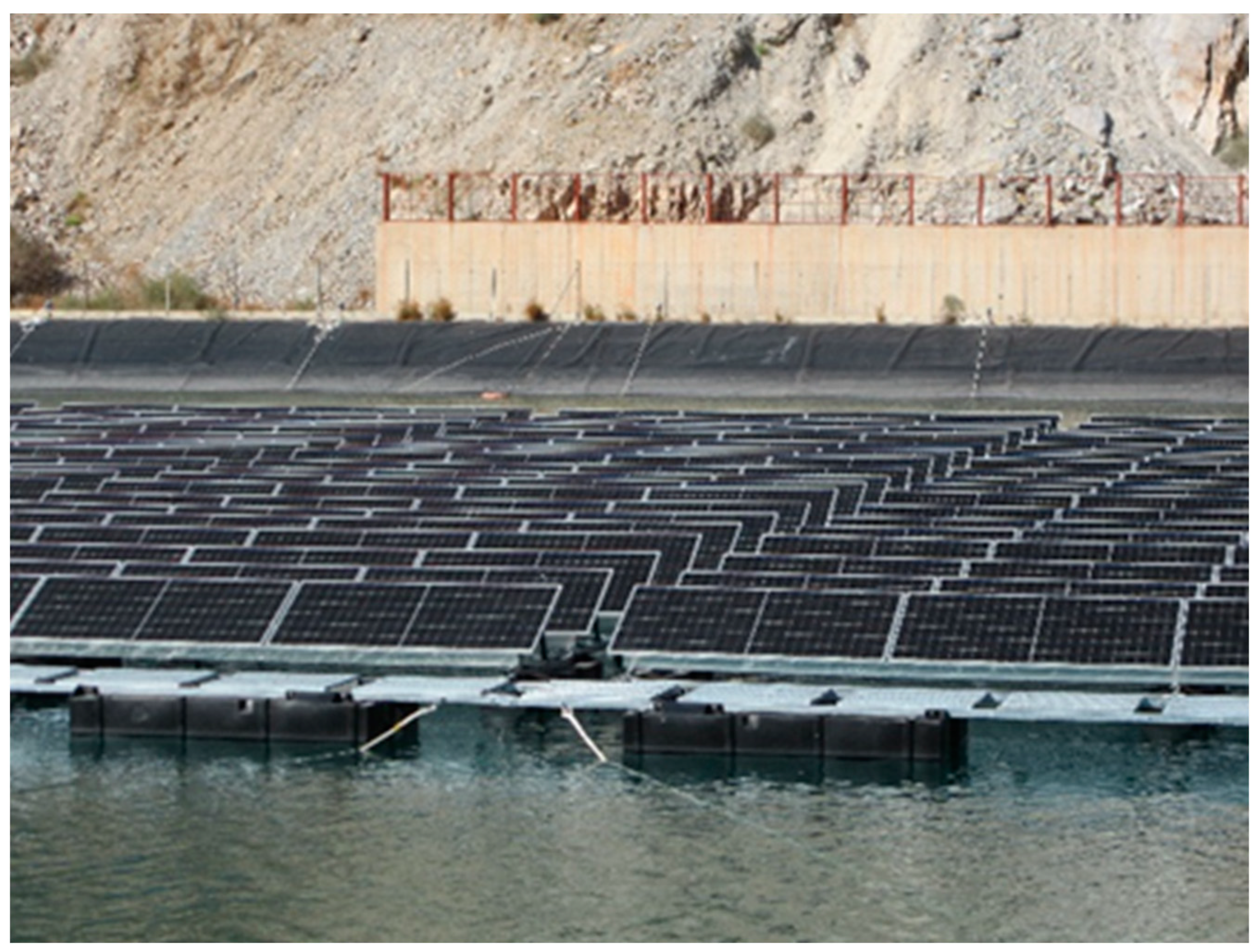
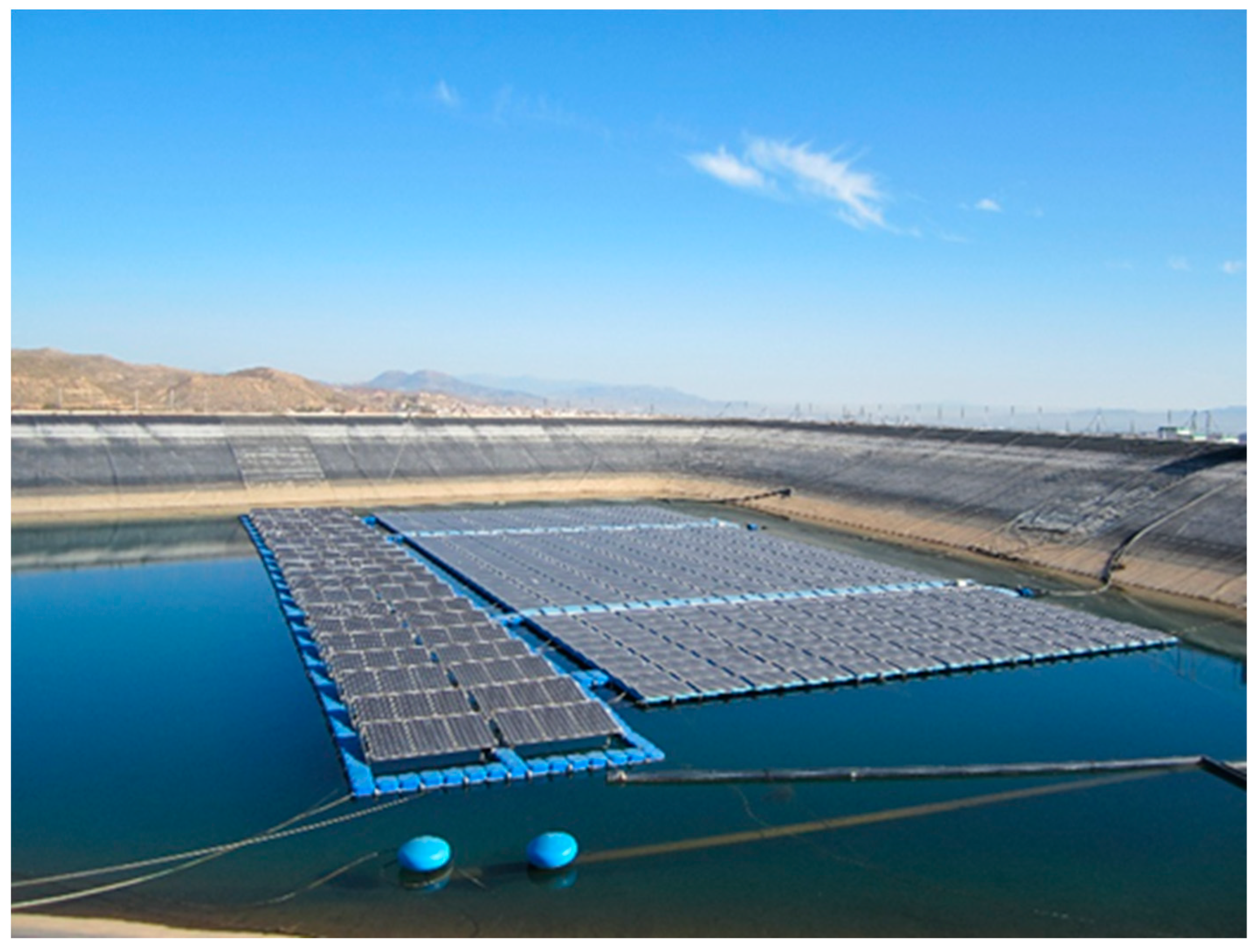
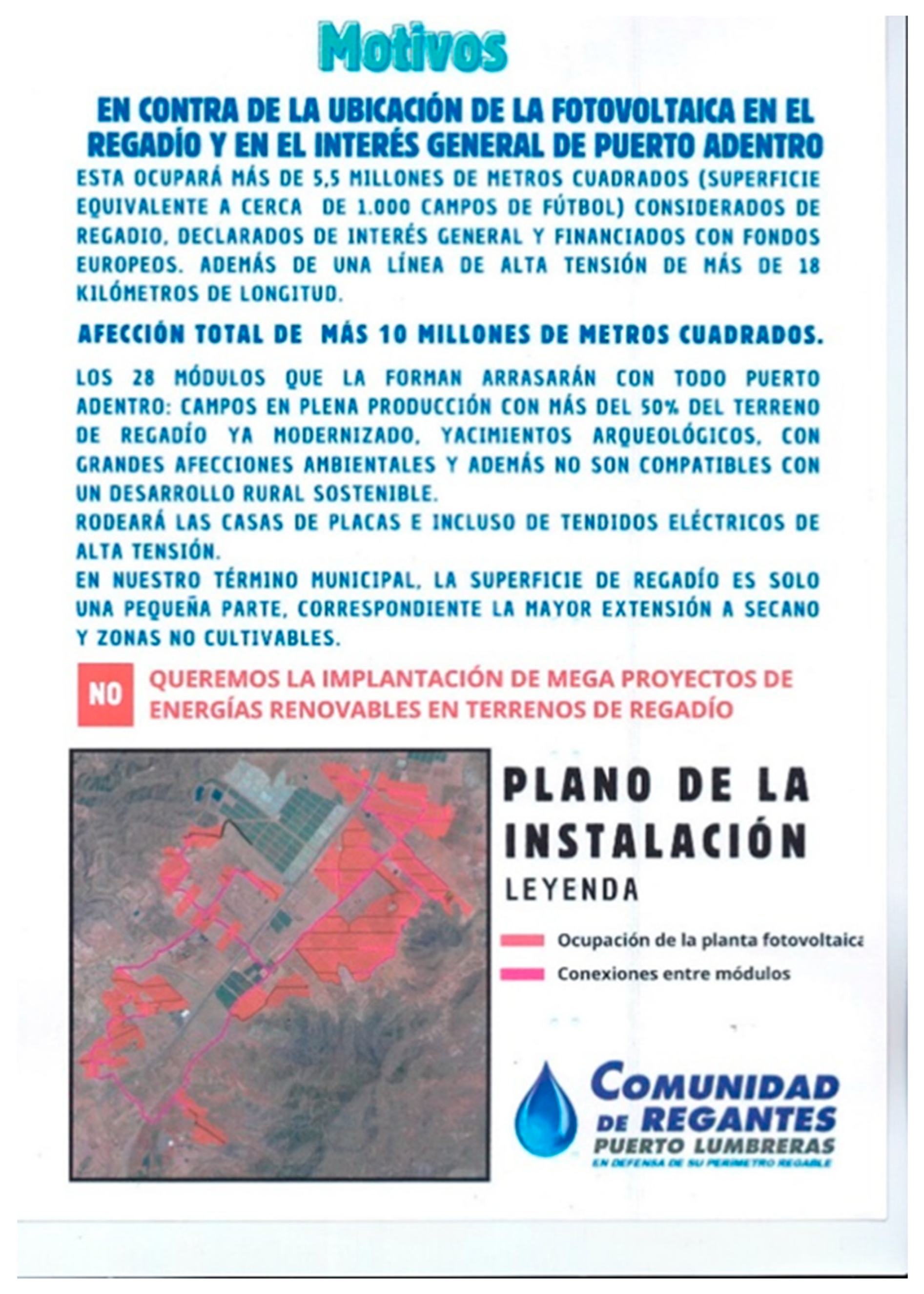
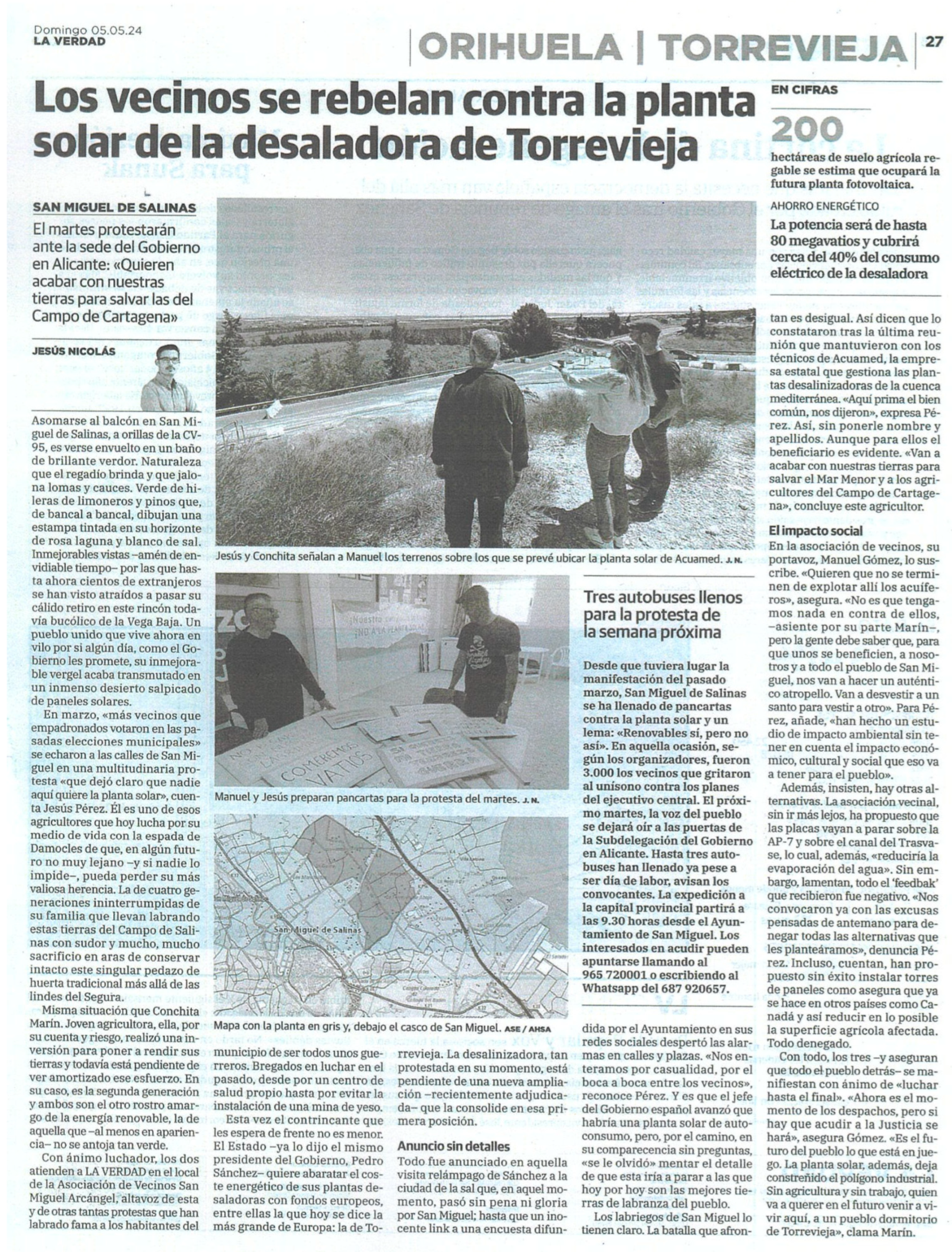
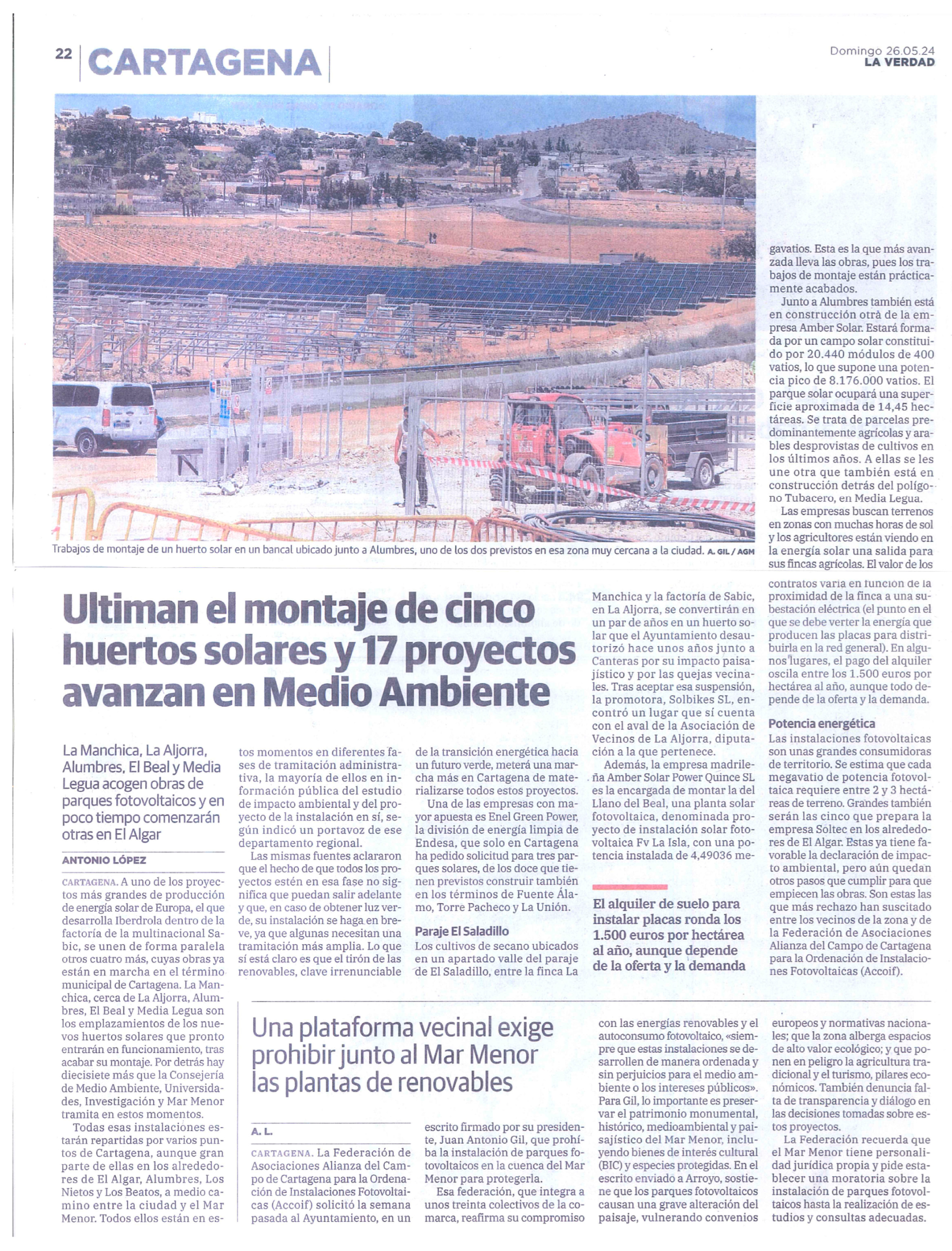
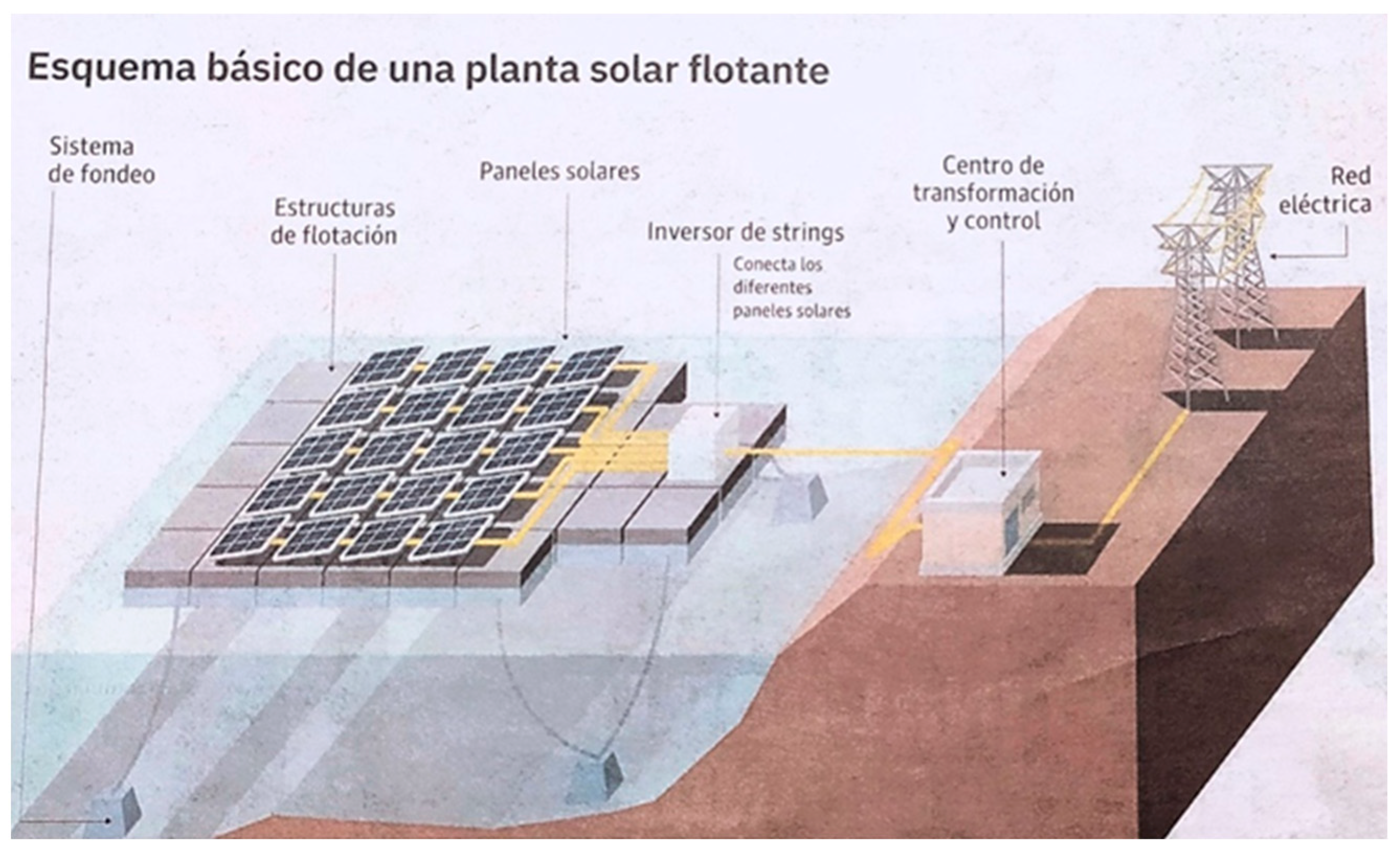
| Year | Dryland Farming | Irrigated Farming | Meadows and Grasslands | Forest Area | Other Land Uses |
|---|---|---|---|---|---|
| 2014 | 359,695 | 187,073 | 85,435 | 380,156 | 119,032 |
| 2015 | 338,695 | 178,536 | 84,920 | 405,968 | 123,334 |
| 2016 | 259,400 | 167,151 | 163,203 | 416,606 | 125,031 |
| 2017 | 253,269 | 187,834 | 146,882 | 418,375 | 125,227 |
| 2018 | 218,184 | 188,234 | 114,682 | 504,095 | 106,192 |
| 2019 | 222,196 | 189,536 | 110,248 | 502,300 | 107,107 |
| 2020 | 196,805 | 164,216 | 140,283 | 502,301 | 128,014 |
| 2021 | 187,981 | 169,757 | 145,484 | 494,324 | 134,073 |
| 2022 | 193,623 | 169,669 | 135,420 | 497,331 | 135,572 |
| 2023 | 194,526 | 164,294 | 132,586 | 504,323 | 135,916 |
| Nº | Denomination (Place) | Municipality (Province) | Power (MW) | Occupied Surface Area (ha) | Entry into Operation |
|---|---|---|---|---|---|
| 1 | Photovoltaic plant Francisco Pizarro | Torrecilla de la Llesa y Aldeacantenera (Cáceres) | 590 | 1300 | 2022 |
| 2 | Photovoltaic plant Núñez de Balboa | Usagre (Badajoz) | 500 | 1000 | 2020 |
| 3 | Photovoltaic solar power plant of Mula | Mula (Murcia) | 494 | 1000 | 2019 |
| 4 | Photovoltaic complex Escatrón-Chiprana-Samper | Escatrón, Chiprana, Samper Salz, (Zaragoza) | 420 | 1400 | 2024 |
| 5 | Photovoltaic plant Guadahortuna | Guadahortuna (Granada) | 375 | 1080 | 2024 |
| 6 | Photovoltaic plant Talasol Solar | Talaván (Cáceres) | 300 | 615 | In test (2020) |
| 7 | Talayuela Solar | Talayuela (Cáceres) | 300 | 800 | In test (2020) |
| 8 | Photovoltaic plant Valdesolar | Valdeacaballeros (Badajóz) | 264 | 700 | 2021 |
| 9 | La Isla | Alcala de Guadaira (Sevilla) | 182 | 520 | 2020 |
| 10 | Calzadilla B | Bienvenida (Badajoz) | 180 | 180 | Exploitation authorization (2020) |
| 11 | Photovoltaic plant Don Rodrigo | Alcalá de Guadaira y Utrera (Sevilla) | 174 | 300 | 2021 |
| 12 | Guillena | Guillena (Sevilla) | 121 | 280 | 2020 |
| 13 | Photovoltaic park Olmedilla de Alarcón | Olmedilla de Alarcón (Cuenca) | 85 | 350 | 2008 |
| 14 | Photovoltaic park El Bonal | Puertollano (Ciudad Real) | 79 | 115 | 2021 |
| 15 | Photovoltaic solar plant La Magascona y La Magasquilla | Trujillo (Cáceres) | 60 | 235 | 2011 |
| 16 | Photovoltaic park Picón I, II y III | Porzuma (Ciudad Real) | 50 | 90 | 2019 |
| 17 | Solar plant Arnedo | Arnedo (La Rioja) | 30 | 70 | 2008 |
| 18 | Solar park SPEX | Mérida y Don Álvaro (Badajoz) | 30 | 195 | 2008 |
| 19 | Solar plant Osa de La Vega | Osa de La Vega (Cuenca) | 30 | 80 | 2008 |
| 20 | Photovoltaic park Casa de Los Pinos | Cuenca (Cuenca) | 28 | 180 | 2008 |
| Municipality | Number of Installations | Power (KW/h) |
|---|---|---|
| Mula | 144 | 505,916.10 |
| Jumilla | 517 | 257,637.54 |
| Murcia | 511 | 169,979.41 |
| Lorca | 896 | 140,346.35 |
| Cartagena | 129 | 138,905.39 |
| Fuente Álamo | 297 | 123,529.01 |
| Totana | 73 | 103,039.36 |
| Yecla | 179 | 63,463.85 |
| Calasparra | 128 | 57,351.95 |
| Alhama de Murcia | 497 | 55,972.44 |
| Puerto Lumbreras | 85 | 45,513.00 |
| Las Torres de Cotillas | 13 | 29,470.49 |
| Cieza | 323 | 28,915.85 |
| Subtotal over 25.000 KW | 3792 | 1,474,040.74 |
| Percentage Subt./Total | 71.53% | 77.57% |
| Blanca | 125 | 17,632.81 |
| Moratalla | 48 | 16,831.50 |
| Mazarrón | 158 | 15,747.32 |
| Abanilla | 250 | 13,676.00 |
| Molina de Segura | 201 | 12,937.40 |
| Campos del Río | 20 | 11,724.00 |
| Torre Pacheco | 49 | 11,240.93 |
| Caravaca de La Cruz | 122 | 10,768.93 |
| Subtotal over 10.000 KW | 4765 | 1,584,599.63 |
| Percentage Subt./Total | 89.89% | 83.38% |
| Total of the 45 municipalities of the Region of Murcia | 5301 | 1,900,350.13 |
| Beneficiary | Municipality | Eligible Investment Budget (EUR) | Aid Granted (EUR) |
|---|---|---|---|
| C.R. Ascoy, Benís y Carrasquilla | Cieza | 1,299,402.03 | 300,000.00 |
| C.R. Puerto Lumbreras | Puerto Lumbreras | 442,039.65 | 132,611.90 |
| C.R. La Isla de la Matanza | Santomera | 198,497.08 | 59,549.12 |
| C.R. de Águilas | Águilas | 1,172,029.51 | 257,838.98 |
| TOTAL | 3,111,968.27 | 750,000.00 |
| Beneficiary | Municipality | Eligible Investment Budget (EUR) | Aid Granted (EUR) |
|---|---|---|---|
| C.R. Miraflores | Jumilla | 2,059,531.33 | 823,812.53 |
| C.R. Pozo del Román Nostrum | Jumilla | 1,109,066.26 | 443,626.50 |
| C.R. Mazarrón | Mazarrón | 2,020,390.83 | 808,156.33 |
| C.R. La Marina | Águilas | 2,122,024.84 | 848,809.94 |
| C.R. Ascoy, Benís y Carrasquilla | Cieza | 1,408,873.13 | 563,549.25 |
| C.R. Pozo de la Aragona | Jumilla | 373,694.42 | 149,477.77 |
| C.R. Azarbe del Merancho | Santomera | 565,216.86 | 226,086.74 |
| C.R. de Puerto Lumbreras | Puerto Lumbreras | 1,399,313.23 | 559,725.29 |
| C.R. Pico de la Tienda de Jumilla | Jumilla | 680,506.43 | 272,202.57 |
| C.R. Hoya del Carche-Ermita | Yecla | 703,226.12 | 281,290.45 |
| C.R. Santo Cristo de la Columna | Jumilla | 771,061.76 | 308,424.70 |
| C.R. Jesús del Gran Poder de Cieza | Cieza | 268,254.84 | 107,301.94 |
| C.R. San Roque | Fortuna | 822,843.92 | 329,137.57 |
| C.R. Pozo Lázaro | Abarán | 832,691.22 | 333,076.49 |
| C.R. del Campo de Cartagena | Cartagena | 1,562,412.59 | 624,965.04 |
| C.R. Hoya del Mollidar-El Portichuelo | Yecla | 1,634,439.22 | 653,775.69 |
| C.R. Heredamiento de la Puebla de Mula | Mula | 220,837.50 | 88,335.00 |
| C.R. de Campotejar | Molina de Segura | 548,034.32 | 219,213.73 |
| C.R. del Pantano de la Cierva | Mula | 468,068.07 | 187,227.23 |
| C.R. TTS Comarca Calasparra-Cieza | Calasparra | 1,738,293.97 | 695,317.59 |
| TOTAL | 21,308,780.86 | 8,523,512.35 |
| Photovoltaic Project Code | Name | Place (Municipality) | Promoter | Power (MW) | Surface (ha) | Previous Use |
|---|---|---|---|---|---|---|
| Pfot 1-003 | Lorca Solar | Lorca y Totana | X-Elio Andaltia Murcia S.L. | 378,590 | 380,00 | Rain-fed herbaceous crops and steppe scrubland |
| Pfot-008 | Carril | Puerto Lumbreras y Lorca | Desarrollos Fotovoltaicos Carril 400 S.L.U. | 360,000 | 461,00 | Horticultural irrigation |
| Pfot-044 | Campos 115 | Campos del Rio | SPG Gestora Yechar S.L. | 85,000 | 96,19 | Rain-fed |
| Pfot-127 | El Molino | Mula y Campos del Río | Marpani Solar 6 S.L. | 84,800 | 121,90 | |
| Pfot-252 | Luminora Solar Tres | Murcia y Torre Pacheco | Luminora Solar Tres S.L. | 88,669 | 172,58 | Rain-fed herbaceous crops and woody crops, Irrigated vegetable crops |
| Pfot-253 | Luminora Solar Dos | Murcia, San Javier y San Pedro del Pinatar | Luminora Solar Dos S.L. | 196,854 | 286,00 | Irrigated vegetable crops and rain-fed herbaceous crops |
| Pfot-261 | FV Pinatar | San Pedro del Pinatar | Fotovoltaiza Zarafot 6 S.L. | 93,170 | 177,43 | Non-citrus fruit trees and irrigated vegetable crops |
| Pfot-263 | Balsicas | Torre-Pacheco | Energías Renovales de la Región de Murcia S.A. | 85,925 | 177,15 | |
| Pfot-264 | Balbona | Jumilla | Enel Green Power España S.L. | 130,600 | 127,48 | |
| Pfot-283 | La Flota II | Fortuna | Maristella Directorship S.L. y Marpani Solar 1 S.L.U. | 87,343 | 173,00 | Abandoned crops and scrubland |
| Pfot-386 | Murcia I | Mula | Cobra S.L. | 199,92 | 405,45 | Rain-fed woody crops (almond and olive), arable land and pasture |
| Pfot-305 | Mula II | Campos del Río y Mula | Cobra S.L. | 114,40 | 280,00 | Rain-fed and pasture |
| Pfot-386 | Mula III | Mula | Cobra S.L. | 65,00 | 132,95 | Rain-fed woody crops (almond and olive), arable land and pasture |
| Pfot-434 | Parque Fotovoltaico Fausita Solar | Murcia y Torre Pacheco | Desarrollos Renovables Iberia Alpha S.L. | 250,00 | 598,00 | Irrigated vegetable crops, rain-fed and scrubland |
| Pfot-468 | Campos | Mula y Campos del Río | Enel Green Power España, S.L. | 109,2 | 137,80 | Rain-fed woody crops and irrigated trees (almond, apricot, and lemon trees) |
| Pfot-795 | Parque Fotovoltaico Rojalinda | Murcia | Energía, Innovación y Desarrollo Fotovoltaico S.A. | 70,80 | 97,50 | Rain-fed woody crops (almond) |
Disclaimer/Publisher’s Note: The statements, opinions and data contained in all publications are solely those of the individual author(s) and contributor(s) and not of MDPI and/or the editor(s). MDPI and/or the editor(s) disclaim responsibility for any injury to people or property resulting from any ideas, methods, instructions or products referred to in the content. |
© 2025 by the authors. Licensee MDPI, Basel, Switzerland. This article is an open access article distributed under the terms and conditions of the Creative Commons Attribution (CC BY) license (https://creativecommons.org/licenses/by/4.0/).
Share and Cite
Martínez-Medina, R.; Gil-Meseguer, E.; Gómez-Espín, J.M. Changes in Land Use Due to the Development of Photovoltaic Solar Energy in the Region of Murcia (Spain). Land 2025, 14, 1083. https://doi.org/10.3390/land14051083
Martínez-Medina R, Gil-Meseguer E, Gómez-Espín JM. Changes in Land Use Due to the Development of Photovoltaic Solar Energy in the Region of Murcia (Spain). Land. 2025; 14(5):1083. https://doi.org/10.3390/land14051083
Chicago/Turabian StyleMartínez-Medina, Ramón, Encarnación Gil-Meseguer, and José María Gómez-Espín. 2025. "Changes in Land Use Due to the Development of Photovoltaic Solar Energy in the Region of Murcia (Spain)" Land 14, no. 5: 1083. https://doi.org/10.3390/land14051083
APA StyleMartínez-Medina, R., Gil-Meseguer, E., & Gómez-Espín, J. M. (2025). Changes in Land Use Due to the Development of Photovoltaic Solar Energy in the Region of Murcia (Spain). Land, 14(5), 1083. https://doi.org/10.3390/land14051083








